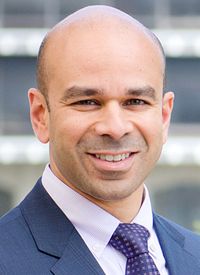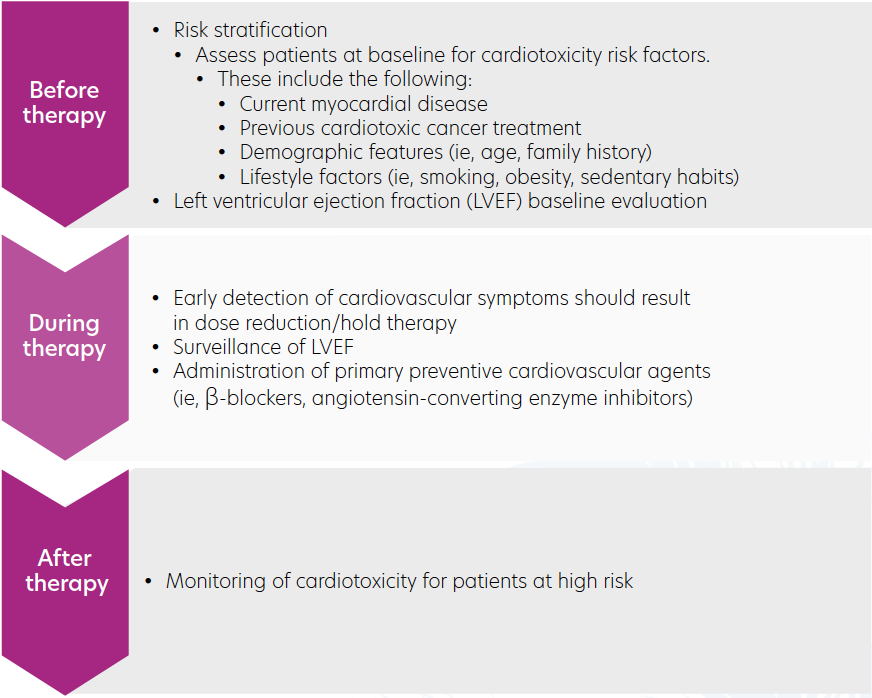Article
Cardio-Oncology Strategies Can Improve Survivorship for Patients With Breast Cancer
Author(s):
Treatment strategies for patients with breast cancer, especially the combination of anthracyclines and HER2-targeted therapies, come with an increased risk of heart failure and cardiac toxicity.
Mandar Aras, MD, PhD

Treatment strategies for patients with breast cancer, especially the combination of anthracyclines and HER2-targeted therapies, come with an increased risk of heart failure and cardiac toxicity.1 To prevent patients with breast cancer from also becoming patients with heart disease, primary prevention and cardiovascular surveillance strategies must be in place over the course of treatment, according to Mandar Aras, MD, PhD, assistant professor of medicine and cardiology at the University of California, San Francisco.
“Patients who have existing cardiovascular issues are most at risk, including those with cardiovascular risk due to uncontrolled blood pressure, uncontrolled cholesterol, or uncontrolled diabetes. If we can manage these risks before they start chemotherapy, that can be very helpful,” he said.
However, even those without preexisting cardiac conditions may experience cardiomyopathy with or without overt heart failure, which is associated with risks treatments for breast cancer. “Anthracyclines and the targeted therapies against the HER2 pathway, such as trastuzumab [Herceptin], have a well-documented and well-established risk of causing cardiomyopathy.”
Risk assessment prior to initiating therapy can help build treatment strategies to reduce the occurrence of severe or fatal cardiac adverse events. These strategies can include a combination of preventive measures, cardiac surveillance while on treatment, and drug interventions such as the use of β-blockers or angiotensin-converting enzyme (ACE) inhibitors (Figure1).
Figure. Management of Cardiotoxicity in Patients With Breast Cancer1

Anticipating Cardiovascular Toxicities of Therapy
As it stands, the evaluation of left ventricular ejection fraction (LVEF) has played a substantial role in identifying those at risk for and minimizing the occurrence of posttreatment heart failure. Although LVEF decline is observed after myocardial deformation has begun, timely treatment with β-blockers or ACE inhibitors and/or a reduction in cancer therapy has led to improved outcomes for patients.1 Guidelines differ on the timing for the evaluation of LVEF; the National Comprehensive Cancer Network guidelines recommend the evaluation of LVEF before and during treatment, with 12-month follow-up for patients who receive anthracyclines who have elevated cardiovascular risk.2 Further, the FDA recommends that clinicians use trastuzumab, pertuzumab (Perjeta)3, and ado-trastuzumab emtansine (T-DM1; Kadcyla)4 in patients whose LVEF is above 50% and delay or discontinue their use in patients whose LVEF declines during treatment.
Results of studies examining the correlation between breast cancer treatment and cardiac toxicity have begun to show that, with management, patients with breast cancer at high risk for cardiac events can be treated safely. For example, in 2021 investigators of the SAFE-HEaRt trial (NCT01904903) published long-term follow-up results showing that it is possible to administer targeted therapy to patients with HER2-positive breast cancer and reduced LVEF.5
In SAFE-HEaRt, 15 patients were treated with trastuzumab, 14 patients were treated with trastuzumab and pertuzumab, and 2 were treated with T-DM1. Patients had stage I to IV breast cancer and were receiving or planned to receive 1 of the 3 treatment regimens in the neoadjuvant or metastatic setting. Patients with LVEF 40% to 49% prior to study participation were eligible.
Mean LVEF was 44.9% at baseline and improved to 52.1%. Twenty-seven patients (90%) completed the planned HER2-targeted therapies. Of the 23 patients evaluated for follow-up, 1 patient developed symptomatic heart failure with no change in LVEF. One patient withdrew from the study for reasons unrelated to the trial, and thus was not included in the analysis. There were no cardiac deaths during the study period.5
All patients received serial echocardiograms, β-blockers, and ACE inhibitors. The primary end point was completion of the therapy without developing either a cardiac event (defined as heart failure, myocardial infarction, arrhythmia, or cardiac death) or significant asymptomatic worsening of LVEF. The study was considered successful if the planned oncology therapy completion rate was at least 30%.
Twenty-one patients met the primary end point of the trial. Fifteen of these patients had LVEF recovery to at least 50%, and at the time of analysis, 9 patients were on cardiac medication and 6 were off medication; 5 patients with stable LVEF (40%-49%) were asymptomatic on cardiac medication; and 1 patient with suggestive symptoms of heart failure but stable LVEF had not sought medical care.5,6
“This is very exciting and very informative because we would be excluding these patients from the therapy that they needed for their breast cancer if we shied away from it because of the low [ejection fraction],” Aras said. “This was an important study and an important first step in helping us understand the risks.”
Mixed Results for Cardiovascular Agents
Earlier study results on the primary prevention of cardiovascular adverse effects demonstrated some signals that cardiac events may be managed with the use of β-blockers or ACE inhibitors. However, investigators reported a mixed bag of efficacy findings with these pharmacologic agents in patients treated with anthracyclines or trastuzumab, resulting in an unanswered clinical question for an evidence-based recommendation for their use.
For example, investigators of the PRADA trial (NCT01434134) evaluated women with early breast cancer who were being treated with either adjuvant anthracycline chemotherapy with or without or trastuzumab. These patients also received the angiotensin receptor blocker, candesartan cilexetil (Atacand; n = 32), or the β-blocker metoprolol (n = 30), the combination of the 2 agents (n = 28), or a placebo (n = 30).7
Published in June 2016, findings showed that candesartan reduced the decline in LVEF that occurs during adjuvant therapy. The overall decline from baseline to the end of study was 0.8 (95% CI, –0.4-1.9) percentage points in the candesartan group and 2.6 (95% CI, 1.5-3.8) percentage points in the placebo group in the intention-to-treat analysis (P = .026). No patient developed symptomatic heart failure during the study period.
In another study, MANTICORE (NCT01016886), patients with HER2-positive early breast cancer were randomly assigned to receive treatment with the ACE inhibitor perindopril, the β-blocker bisoprolol, or placebo during trastuzumab adjuvant therapy.8 Investigators found that perindopril and bisoprolol were well tolerated and protected against declines in LVEF related to cancer therapy, but the primary end point— prevention of trastuzumab-mediated left ventricular remodeling—was not met.
Further, findings from the CECCY trial (NCT01724450) suggested that the use of the β-blocker carvedilol protected against myocardial injury but did not result in significant change in LVEF. The study assessed patients with HER2-negative breast cancer being treated with anthracycline chemotherapy. Patients were randomized to either carvedilol (n = 96) or placebo (n = 96) during chemotherapy treatment. The primary end point of prevention of 10% or greater reduction in LVEF at 6 months was achieved in 14.5% of patients in the carvedilol arm and 13.5% in the placebo arm (P = 1.0).9 Investigators reported a lower incidence of diastolic dysfunction in the carvedilol group compared with the placebo group (P = .039).
Aras recommended close communication between oncologists and cardiologists. “Screening and monitoring these patients is the best strategy. Patients who have existing cardiovascular issues are most at risk for cardiotoxicities related to cancer treatment. Managing these cardiac risk factors before starting chemotherapy is the best way to prevent these cardiotoxicities.”
He predicted more partnerships between oncology and cardiology in the future. “My role in the care of the cancer patient is to work with the oncologist once a patient has been identified as being high risk or if they have some toxicity that affects their heart. A lot of centers are going to have a cardiologist embedded in their cancer center to help address many of these issues. A cardiologist can also play a role in survivorship,” Aras said.
Other treatment strategies for patients with breast cancer are also under evaluation for cardiac toxicity, including immune checkpoint inhibitors. Although some patients with breast cancer who have been treated with immunotherapies have experienced cardiac toxicities, the data are not well fleshed out, Aras said. “Immunotherapies are super exciting, and they have revolutionized cancer treatment. There are reports of cardiac toxicity, even fatal cardiac toxicity, with the use of combination checkpoint inhibitors. This [adverse event] was seen in other cancer types such as melanoma and lung cancer.”
One review found that cardio toxicities related to immunotherapy are not common but can be severe and include fulminant heart failure, hemodynamic instability, and cardiac arrest.10
References
- Cardinale D, Caruso V, Cipolla CM. The breast cancer patient in the cardioncology unit. J Thorac Dis. 2018;10(suppl 35):S4306-S4322. doi:10.21037/ jtd.2018.10.06
- NCCN. Clinical Practice Guidelines in Oncology. Breast cancer, version 1.2021. Accessed February 22, 2021. https://www.nccn.org/professionals/physician_gls/pdf/breast.pdf
- Perjeta. Prescribing information. Genentech Inc; 2020. Accessed February 22, 2021. https:// www.accessdata.fda.gov/drugsatfda_docs/label/2020/125409s124lbl.pdf
- Kadcyla. Prescribing information. Genentech Inc; 2020. Accessed February 22, 2021. https:// www.accessdata.fda.gov/drugsatfda_docs/label/2020/125427s108lbl.pdf
- Khoury K, Lynce F, Barac A, et al. Long-term follow-up assessment of cardiac safety in SAFE-HEaRt, a clinical trial evaluating the use of HER2-targeted therapies in patients with breast cancer and compromised heart function. Breast Cancer Res Treat. Published online January 3, 2021. doi:10.1007/ s10549-020-06053-y
- Khoury K, Barac A, Lynce F, et al. Long-term follow-up assessment of cardiac safety in SAFE-HEaRt, a clinical trial evaluating the use of HER2-targeted therapies in patients with breast cancer and compromised heart function. J Clin Oncol. 2020;38(suppl 15):12069. doi:10.1200/JCO.2020.38.15_suppl.12069
- Gulati G, Heck SL, Ree AH, et al. Prevention of cardiac dysfunction during adjuvant breast cancer therapy (PRADA): a 2 x 2 factorial, randomized, placebo-controlled, double-blind clinical trial of candesartan and metoprolol. Eur Heart J. 2016;37(21):1671-1680. doi:10.1093/eurheartj/ehw022
- Pituskin E, Mackey JR, Koshman S, et al. Multidisciplinary approach to novel therapies in cardio-oncology research (MANTICORE-101-Breast): a randomized trial for the prevention of trastuzumab-associated cardiotoxicity. J Clin Oncol. 2017;35(8):870-877. doi:10.1200/JCO.2016.68.7830
- Avila MS, Ayub-Ferreira SM, de Barros Wanderley MR Jr, et al. Carvedilol for prevention of chemotherapy-related cardiotoxicity: the CECCY trial. J Am Coll Cardiol. 2018;71(20):2281-2290. doi:10.1016/j. jacc.2018.02.049
- Zarifa A, Salih M, Lopez-Mattei J, et al. Cardiotoxicity of FDA-approved immune checkpoint inhibitors: a rare but serious adverse event. J Immunother. 2018;1(2)68-77. doi:10.4103/JIPO.JIPO_15_18







%20u.jpg?fit=crop&auto=format)

